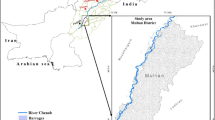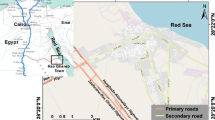Abstract
In the Bali and Pali tehsils of Pali district of western Rajasthan, which were affected by floods during the period August 6–10, 1990, using IRS-1A LISS-1 data of post-flood and ground truth, seven flood damage categories viz. (1) loss of bund and slight sheet erosion (2) loss of bunds, severe sheet and rill erosion and few gullies (3) deep gullies (4) water inundated area (5) moderate scouring and sand casting (6) severe scouring and sand casting and (7) river widening and bank cutting have been mapped. Out of seven, four categories could be mapped visually on the raw FCC (post-flood) and remaining three categories could be separated out from the digitally generated FCC. The PC2 was found to contain maximum information on soil erosion/deposition and inundated areas. Density-slicing of band-ratioed output gave maximum information on newly formed channels, water bodies and flow direction. The damage caused to be human beings, animals, agricultural lands, engineering structure by different type of flood hazards under various geomorphic flood zone and comparison between pre-flood and post-flood product has been highlighted.
Similar content being viewed by others
References
Anil Kumar and Chhonkar R P S (1989). Flood inundation mapping in part of Mahanadi river basin.Journal of the Indian Society of Remote Sensing, 17, 13–16.
Chakraborty A K (1979). Study of Kosi river characteristics using air borne, space orbital multispectral scanner data. Proceeding of symposium on contribution of space observation to water resources studies and the management of these resources, COSPAR.
Dhir R P (1982). July 1979 Flash flood in the Luni — a case study Central Arid Zone Research Institute, Jodhpur, Technical Report, 6, 33 pp.
Dhanju M S (1976). Studies of Kosi river flood by remote sensing.Hydrological Review, 2, 163–168.
Kolarkar A S, Sharma B K and Dhir R P (1983). Impact of flash flood on agricultural land in Jaipur region of Rajasthan.Journal of Indian Society of Soil Science, 31, 580–86.
Kolarkar A S and Singh N (1983). Upper Luni basin, an integrated analysis of natural and human resources for development planning. Technical Report 86–187 pp.
Singh S, Sharma K D, Singh Nepal and Bohra D N (1988). Temporal changes detection in river courses and flood plains in an arid environment through satellite remote sensing.Journal of Indian Society Remote Sensing, 16, 53–56.
Sharma K D, Singh Surender, Singh Nepal and Kalla A K (1989). Role of satellite remote sensing for monitoring of surface water resources in an arid environment.Journal des Science Hydrologiques, 34, 531–537.
Vats P C (1985). Geomorphological factors affecting land utilization in Pali district, western Rajasthan.The Geographical Observation, 21, 11–18, Meerut.
Vats P C (1986). Environmental problems of Pali district. Desert environment conservation and management,CAZRI Publication, 26, 95–100 pp.
Author information
Authors and Affiliations
About this article
Cite this article
Singh, N., Vangani, N.S. & Sharma, J.R. Flash flood damage mapping in arid environment using satellite remote sensing — A case study of pali region. J Indian Soc Remote Sens 21, 75–86 (1993). https://doi.org/10.1007/BF02996345
Received:
Accepted:
Issue Date:
DOI: https://doi.org/10.1007/BF02996345




